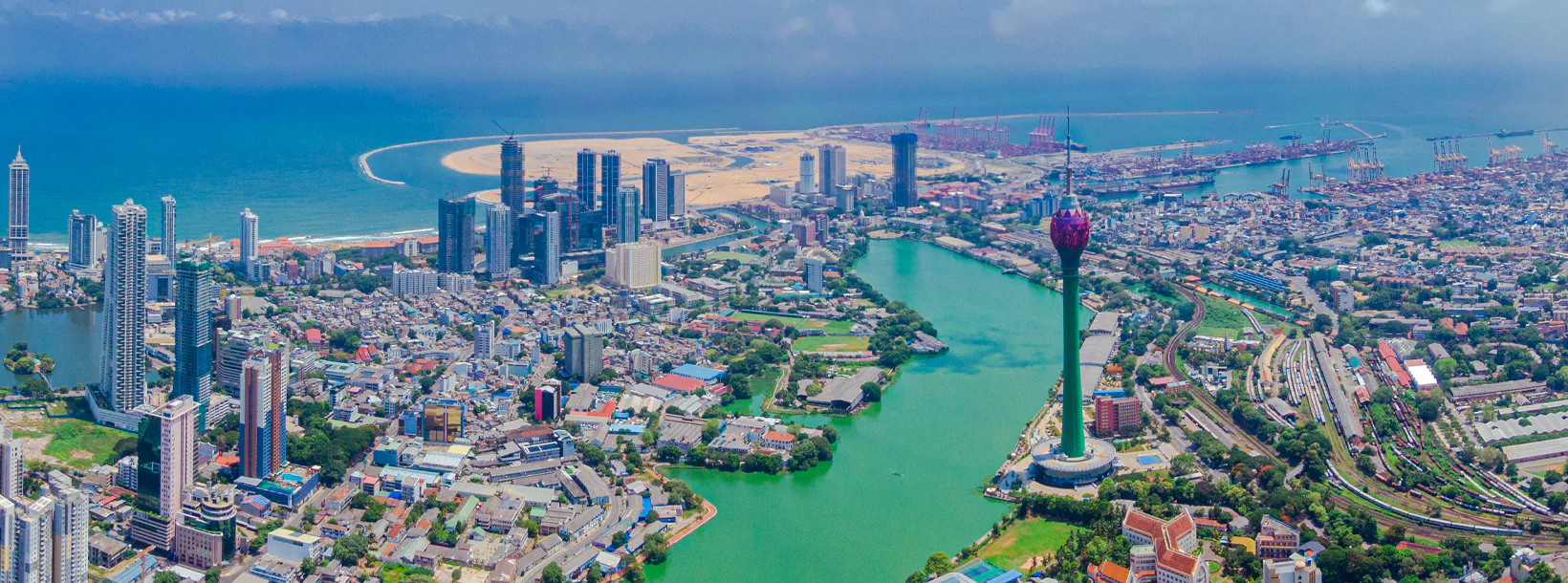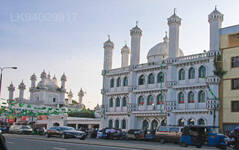
Colombo City
Colombo, the capital of Sri Lanka, is a dynamic city blending tradition and modernity. It showcases colonial architecture, lively markets, and serene Buddhist temples. With diverse cuisine, a growing skyline, and beautiful beaches, it's a vibrant hub for business, culture, and tourism, offering a gateway to explore Sri Lanka's wonders.
Dewatagaha Mosque
Dawatagaha Mosque in Lipton Circus, Colombo, has become a byword in every Muslim home and no Muslim passes the shrine of the saint without paying his respects.
The 150-year-old shrine the resting-place of the Muslim saint\ His Holiness Seyedina as-Sheikh Usman Siddique Ibn Ahdurrahman, who visited Ceylon from Arafat, Arabia and visited Adam’s Peak at Balangoda, and later resided in what was later known as Cinnamon Gardens, has an interesting history behind it.
In 1820 a Sinhalese woman oil monger, the sole wage-earner of the family, was going on her daily rounds, traveling from Bambalapitiya through the cinnamon jungle to Maradana.
In this jungle she tripped over the root of a Cadju tree and fell. Her clay pot was smashed to pieces. “Aiyo, Aiyo!” she cried out, “My family will have no food today. My only means of earning has been destroyed.” She wept her eyes out in desperation and exhausted, fell fast asleep. A voice awakened her. It asked her not to despair and bade her rise, assuring her that everything would be well soon. She looked up and found no one in sight and in desperation burst into tears again.
Again the voice repeated the reassuring words. This was incredible as she had hardly seen any human being within earshot in that dense jungle. Suddenly she saw an old man in green garb and his holy mien was an inspiring sight to the stricken woman.
“You have nothing to fear,” he told her. “I shall give you back your oil. Only fetch me a pot.”
The woman started towards Maradana to the house of a regular customer, a Muslim by the name of Mamma Lebbe, and asked his mother to give her a new pot. When the latter queried this strange request the oil monger said: “I shall come back and tell you my story.” She returned with the pot to the jungle to find the old man reclining against a `Dawata’ or `Devata’ tree. He directed her to place the pot where the first one was broken. He pressed his foot on the ground and beheld, oil bubbled up from the ground!
The woman was speechless with amazement. Picking some leaves from a Cadju tree he asked her to scoop up the oil with them and fill her pot. “You can now earn your living,” he told her and also requested her to inform her Muslim customers and show them the spot where he appeared. The grateful oil monger made obeisance to the saint and invoked his blessings.
She hurried to the house of Mamma Lebbe and related her story of the miracle to Mamma Lebbe’s mother. A party comprising Mamma Lebbe, Periya Pitche, Meera Kani, and the oil monger left for the spot to investigate and found evidence of the miracle the broken pot, the seeping oil, the Cadju tree, and the Cadju leaves the Dawata tree.
The party of Mushinis recited Yaseen and Fathiha and prayed: “Oh Vohiyullah (saint)! Praise is to Allah for having given us the opportunity to bear witness to your miracle. Almighty Allah, may you reveal to us the identity of this Vohiyullah.”
They returned to Mamma Lebbe’s mother and vouched for the truth of the miracle and the accuracy of the woman’s report. They bought up the rest of the woman’s oil after she had finished her rounds and dismissed her after giving her a good meal. The Muslims of the area appointed Maniema Lebbe as their leader and Trustee of the shrine. The identity of the saint was still unknown.
In 1847, twenty-seven years after the miracle, there came from the Maghreb to this island a divine Sheikh Ali Jahbarooth Moulana, who took up his residence at the Maradana Mosque, Colombo. He was informed of the Dawatagaha miracle and on an appointed Friday, after Jumma prayers, a party of Muslims headed by Jahbarooth Moulana and including Katheeb Assena Lebbe, Sheikh Abdul Qadir, and others proceeded to the shrine and recited Kath ham Fatiha.
Jahbarooth Moulana identified the grave of the saint. He shrouded himself with his jubbah’ (robe), knelt by the grave, and sought communion with the saint. When he finally emerged from the shroud his face seemed ablaze with divine light. He announced to the assembled Muslims:
“Oh, Almighty Allah, this is a most venerable saint. His name is Seyed Usman Siddique Ibn Abdurrahman, one who came to this island on a pilgrimage to Adam’s Peak and after living in the vicinity for some time, died here.” He then turned to Katheeb Thambi Lebbe and said, “What month is this?”
Katheeb Thambi Lebbe said, “Today is the fourth day of the Muslim month of Zulqadha.’ Jahbarooth Moulana then told those assembled, “We shall recite Kath ham Fatiha for the ten days of this month every year in the saint’s memory and distribute “niyath.”
He gave a sovereign to the Trustee, Mamma Lebbe, and asked him to prepare ghee rice for the pilgrims. He also asked the Muslims to find a flagpole. A bamboo stalk was found near Mamma Lebbe’s house and handed over to Jahbarooth Moulana who exclaimed “Marhaba! Marhaba!” and tearing a portion of his white turban, made a flag of it, and planted the flagpole at the head of the grave.
About Colombo District
Colombo is the largest city and commercial capital of Sri Lanka. It is located on the west coast of the island and adjacent to Sri Jayewardenepura Kotte, the capital city of Sri Lanka. Colombo is a busy and vibrant city with a mixture of modern life and colonial buildings and ruins and a city population of 647,100.The Colombo Metropolitan Region, defined by the districts of Colombo, Gampaha and Kalutara, has an estimated population of 5,648,000, and covers an area of 3,694.20 km²
Colombo is a multi-ethnic, multi-cultural city. It is the most populous city in Sri Lanka, with 642,163 people living within the city limits. The population of Colombo is a mix of numerous ethnic groups, mainly Sinhalese, Moors and Tamils. There are also small communities of people with Chinese, Portuguese, Dutch, Malay and Indian origins living in the city, as well as numerous European expatriates.
The great majority of Sri Lankan corporations have their head offices in Colombo. Some of the industries include chemicals, textiles, glass, cement, leather goods, furniture, and jewellery. In the city center is located South Asia's second tallest building - The World Trade Centre.
About Western Province
The Western Province is the most densely populated province of Sri Lanka. It is home to the legislative capital Sri Jayawardenepura Kotte as well to Colombo, the nation's administrative and business center. Western Province is divided into 3 main districts called Colombo (642 km²), Gampaha (1,386.6 km²) and Kalutara (1,606 km²) districts. As Sri Lanka's economic hub, all the major local and international corporations have their presence in the city and so do all the major designer and high street retailers, so be ready to indulge in some retail therapy in western province.
Having the highest population in the all the provinces, the almost all the premier educational institutions in the island are located in western province. Universities in the province include the University of Colombo, the University of Sri Jayewardenepura, University of Kelaniya, Open University, Sri Lanka, Buddhist and Pali University of Sri Lanka, General Sir John Kotelawala Defence University and University of Moratuwa .Western province has the largest amount of schools in the country, which includes National, Provincial, Private and International schools.










































